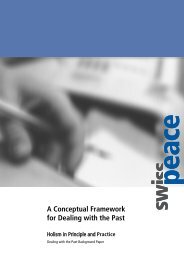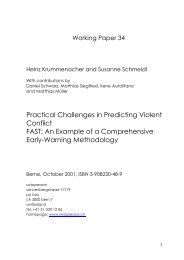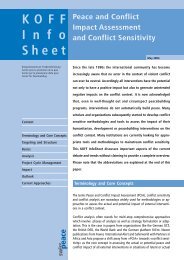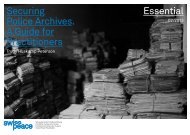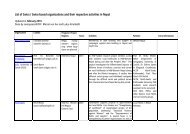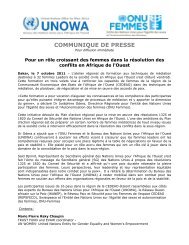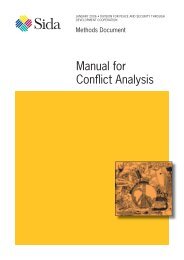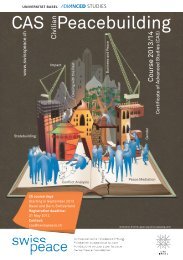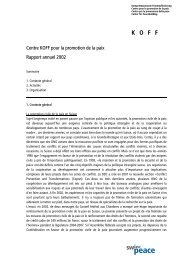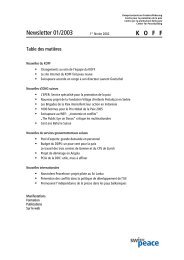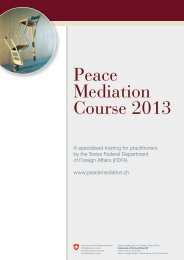Unpacking the Mystery of Mediation in African Peace ... - Swisspeace
Unpacking the Mystery of Mediation in African Peace ... - Swisspeace
Unpacking the Mystery of Mediation in African Peace ... - Swisspeace
Create successful ePaper yourself
Turn your PDF publications into a flip-book with our unique Google optimized e-Paper software.
Burundi, Arusha <strong>Peace</strong> Process<br />
<strong>in</strong>g <strong>the</strong> different negotiators <strong>in</strong> order to ga<strong>in</strong><br />
maximum legitimacy. 16<br />
Pre-Negotiation to <strong>the</strong> Arusha<br />
Agreement<br />
Several East and Central <strong>African</strong> States, <strong>in</strong> conjunction<br />
with <strong>the</strong> OAU, developed a broad peace<br />
<strong>in</strong>itiative to <strong>the</strong> crisis <strong>in</strong> Burundi. In 1996 and<br />
1997, Rwanda, Uganda, DR Congo, Kenya, and<br />
Ethiopia (jo<strong>in</strong>ed by Zambia after October 1996)<br />
demonstrated an unusual degree <strong>of</strong> cohesion and<br />
determ<strong>in</strong>ation <strong>in</strong> push<strong>in</strong>g for a negotiated settlement.<br />
The countries held five Presidential Summit<br />
Meet<strong>in</strong>gs on Burundi between 1996 and<br />
1997, which brought toge<strong>the</strong>r leaders <strong>of</strong> neighbor<strong>in</strong>g<br />
nations to address <strong>the</strong> Burundi situation<br />
and forced <strong>the</strong> <strong>in</strong>ternational community to recognize<br />
<strong>the</strong> conflict’s regional character. 17 They<br />
also engaged former Tanzanian president Julius<br />
Nyerere as <strong>the</strong>ir ‘facilitator’ and sponsored four<br />
major political discussions, hosted by Nyerere,<br />
among <strong>the</strong> Burundian parties. 18 In an exceptional<br />
move, n<strong>in</strong>e regional states19 adopted economic<br />
sanctions <strong>in</strong> 1996 aimed at persuad<strong>in</strong>g <strong>the</strong> Burundian<br />
government to restore constitutional legality<br />
and participate <strong>in</strong> all-party negotiations.<br />
This represented a fundamental shift <strong>in</strong> <strong>in</strong>ter-<br />
<strong>African</strong> relations: For <strong>the</strong> first time, a group <strong>of</strong><br />
leaders declared <strong>the</strong>y would not accept a coup<br />
d’état as a legitimate way for an <strong>in</strong>dividual to<br />
come to power.<br />
The Arusha talks between June 1998 and August<br />
2000 were carried out with<strong>in</strong> this regional<br />
16 Claim<strong>in</strong>g commitment to democratic pr<strong>in</strong>ciples, FRODEBU<br />
ga<strong>in</strong>ed <strong>the</strong> support <strong>of</strong> certa<strong>in</strong> <strong>in</strong>ternational parliamentary organizations.<br />
Oppos<strong>in</strong>g FRODEBU and play<strong>in</strong>g on Western<br />
guilt about <strong>the</strong> Rwandan genocide, <strong>the</strong> Union for National<br />
Progress (UPRONA), a Tutsi group, along with members <strong>of</strong><br />
<strong>the</strong> military, sought to ga<strong>in</strong> <strong>in</strong>ternational endorsement by denounc<strong>in</strong>g<br />
what <strong>the</strong>y claimed was a Hutu plot to exterm<strong>in</strong>ate all<br />
Tutsis (Ibid., p. 149.)<br />
17 Hara (1999): op.cit., p. 145. The war <strong>in</strong>volved neighbor<strong>in</strong>g<br />
states as well. Many CNDD-FDD combatants were based <strong>in</strong><br />
Tanzania and launched <strong>in</strong>cursions <strong>in</strong>to Burundi from <strong>the</strong>re, despite<br />
apparent efforts by <strong>the</strong> Tanzanian government to discourage<br />
<strong>the</strong> activities (Human Rights Watch: “Burundi - Escalat<strong>in</strong>g<br />
Violence Demands Attention”, Brief<strong>in</strong>g Paper (November<br />
2002), (http://hrw.org/backgrounder/africa/burundi/burundi1128.pdf)).<br />
18 Weissman (1998): op. cit.<br />
19 DR Congo, Ethiopia, Eritrea, Kenya, South Africa, Tanzania,<br />
Uganda, and Zambia.<br />
framework, facilitated by Julius Nyerere, and by<br />
Nelson Mandela after <strong>the</strong> death <strong>of</strong> Nyerere <strong>in</strong><br />
1999. Nyerere approached <strong>the</strong> Swiss Federal Department<br />
<strong>of</strong> Foreign Affairs (FDFA) for support.<br />
The Burundian parties wanted French speakers<br />
and also some experts that were not from <strong>the</strong><br />
Nyerere foundation (to balance a perceived bias),<br />
thus <strong>the</strong>y short-listed countries that would be acceptable<br />
as countries that might send experts, and<br />
proposed South Africa and Switzerland for <strong>the</strong><br />
constitutional issues.<br />
Negotiation phase<br />
Participation and Inclusiveness<br />
All political parties to <strong>the</strong> conflict and some <strong>of</strong><br />
<strong>the</strong> armed groups were <strong>in</strong>cluded <strong>in</strong> <strong>the</strong> Arusha<br />
talks. 20 The process was very <strong>in</strong>clusive, as <strong>the</strong> parties<br />
agreed that all political parties could attend.<br />
However, this also led to <strong>the</strong> <strong>in</strong>crease <strong>in</strong> parties as<br />
<strong>the</strong> process developed (with more than 200 delegates).<br />
The ensu<strong>in</strong>g dynamic was for <strong>the</strong> large<br />
parties to br<strong>in</strong>g <strong>in</strong> “<strong>the</strong>ir” parties and “<strong>the</strong>ir” civil<br />
society actors, so that no real new perspectives<br />
were <strong>in</strong>tegrated, although <strong>the</strong>re were more and<br />
more people. This was <strong>the</strong>n brought down to a<br />
manageable number through <strong>the</strong> “sufficient consensus”<br />
approach, gett<strong>in</strong>g <strong>the</strong> large parties to<br />
agree, and <strong>the</strong>n work<strong>in</strong>g with <strong>the</strong> large parties to<br />
get “<strong>the</strong>ir” smaller parties to come on board.<br />
Thus, <strong>the</strong>re was a G7, G8, and G3 group.<br />
Some <strong>of</strong> <strong>the</strong> political parties had a military<br />
branch, so that <strong>the</strong> armed groups were <strong>in</strong> part<br />
also represented at <strong>the</strong> talks. However, at times<br />
<strong>the</strong>re were differences between <strong>the</strong> political and<br />
military branch <strong>of</strong> <strong>the</strong> same movement, so that<br />
<strong>the</strong> respective armed movement did not feel adequately<br />
represented. The CNDD-FDD and <strong>the</strong><br />
Palipehutu-FNL split from <strong>the</strong>ir political w<strong>in</strong>gs<br />
dur<strong>in</strong>g <strong>the</strong> Arusha talks and wanted to replace<br />
<strong>the</strong>se delegations <strong>in</strong> <strong>the</strong> talks. The o<strong>the</strong>r negotiation<br />
parties rejected this, however; thus, <strong>the</strong>se two<br />
20 Key actors on <strong>the</strong> Tutsi side were: <strong>the</strong> army, dom<strong>in</strong>ated by <strong>the</strong><br />
Tutsi until <strong>the</strong> elections <strong>of</strong> 2005, <strong>the</strong> UPRONA party, <strong>the</strong><br />
MRC <strong>of</strong> Colonel Bayanganakandi, and <strong>the</strong> movement AC<br />
Genocide etc. On <strong>the</strong> Hutu side: <strong>the</strong> FRODEBU party, <strong>the</strong><br />
former rebel groups CNDD-FDD, CNDD, FROLINAT, and<br />
Palipehutu-FLN as well as its dissidents.<br />
23




